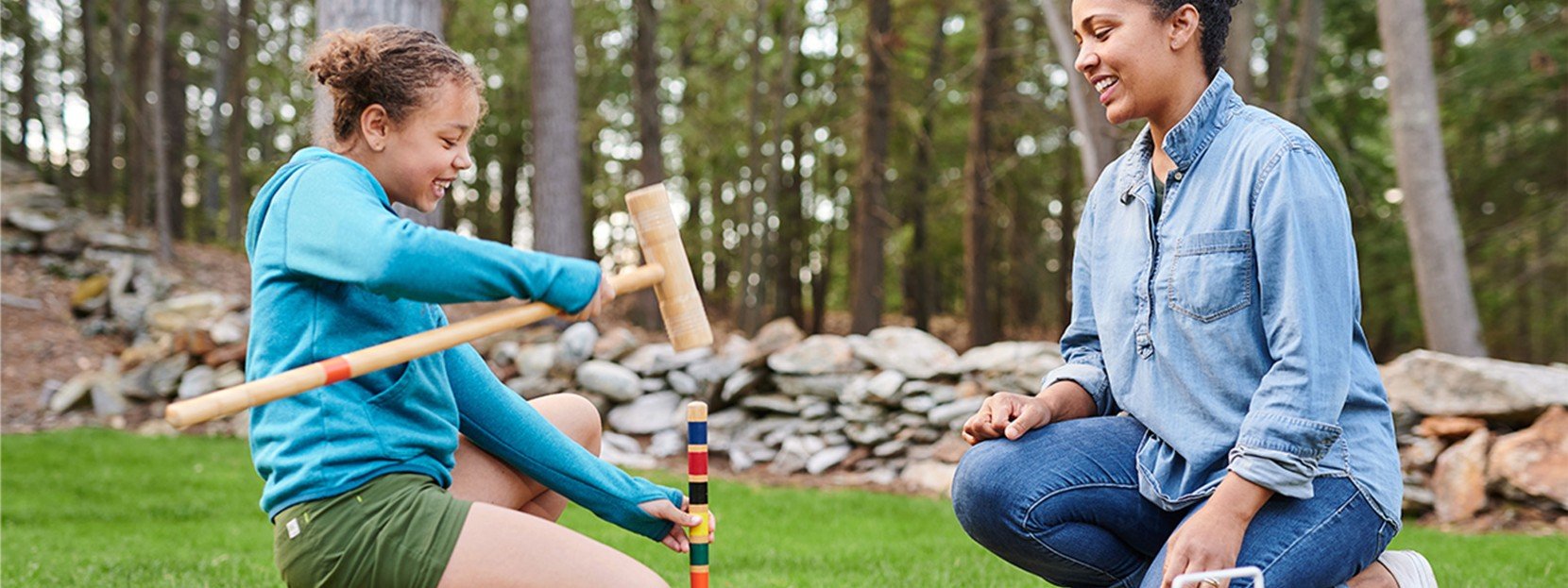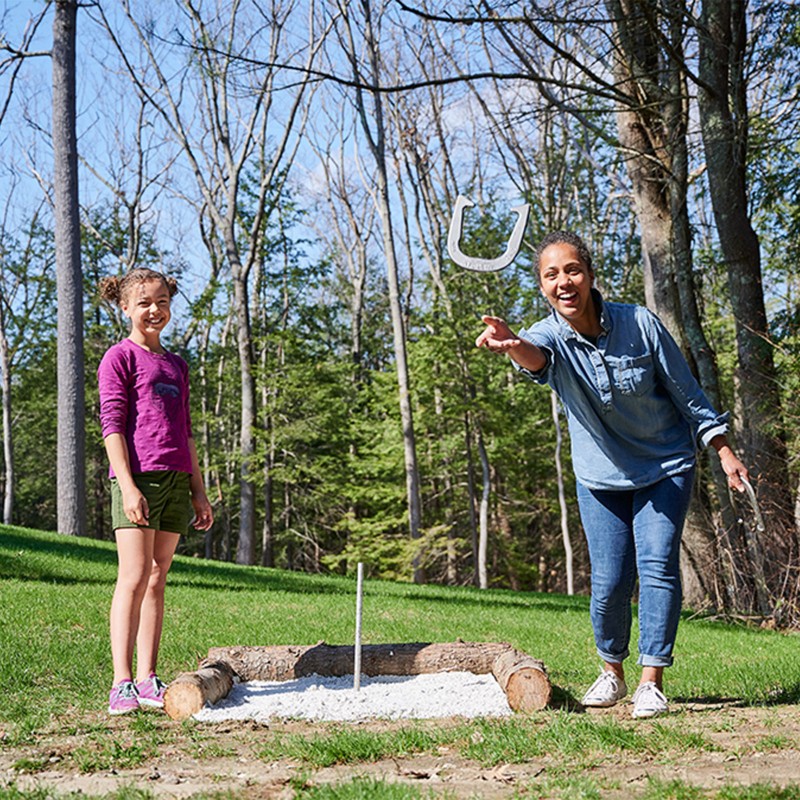
Long summer days are the perfect time to leave the screens inside and head out for some fun in the sun together. Whether you’re playing with family or friends, these classic games are beloved by adults and kids alike: easy to learn, light on equipment and fun to play again and again. Check out our five favorite backyard games – plus a few tips to go beyond the basics and take your technique to the next level.
Croquet
2-6 PLAYERS
If your family likes miniature golf, then they’ll love croquet, which combines some of the obstacle course elements of putt putt with fun opportunities to gain extra strokes and hamper your opponents. The main objective of the game is to mallet your croquet ball through nine gates, or “wickets,” on the flat playing field – but stay on the lookout for other players, who can knock you off course or “send” your ball flying out of bounds. First player to make it through the entire course wins!
MAINE COAST CROQUET SET WITH STAND

QUICK TIP:
Each wicket gets you a bonus stroke, and hitting an opponent’s ball gets you two – but don’t get distracted by the chance to send another ball flying. If going out of your way to send an opponent means taking an extra turn to get back to the wickets, you’ve put yourself in a bad position. Rack up those bonus strokes with the wickets and focus on setting yourself up to win, not make your opponents lose.
Horseshoes
2-4 PLAYERS
As long as horses have been shoed, people have played horseshoes, tossing shoes towards a stake to get that elusive “ringer.” Players or teams take turns tossing horseshoes across the playing field, trying to get closest to a 15-inch spike. Shoes that land within 6 inches get 1 point, and shoes that “ring” the spike get 3 points; games are played to 40 points. It sounds simple, but anybody who has played will tell you that it’s a lot harder once you’re standing on the field. Luckily, play goes quickly, so it’s easy to spend an entire afternoon or evening perfecting your game.

QUICK TIP:
Despite the small size, a standard horseshoe weighs a hefty 2½ pounds, so getting used to the weight and momentum can take some time. Make sure you follow through with your throws and experiment with different styles. Many professionals grip the horseshoe from one of the side shanks, in order to put a little spin on it; others find it easier to hold the shoe from the top and let it flip through the air.


Cornhole
2-4 PLAYERS
Also known as bags, bean toss or sack toss, cornhole is a classic backyard game of aim, control and strategic thinking. Players or teams take turns tossing bean bags across a playing field at a target board with a hole in it; bags on the board are worth 1 point, while bags that slide into the hole (or “airmail” in without touching the board) are worth 3 points; games are played to 21 points. While the scoring is similar to horseshoes, cornhole adds the bocce-like challenge of playing around – or through – your opponents’ bags.

QUICK TIP:
It may be tempting to play aggressively and knock your opponents’ bags off the board, but playing defensively is a better strategy; landing a bag on the board in front of the hole as a “block” will prevent your opponents’ from sliding their bags in – at least not without knocking your bag in and scoring you three points as well.
Badminton
2-4 PLAYERS
Badminton is a simple, classic backyard game played with a net, rackets and a distinctive shuttle called the “shuttlecock” or “birdie.” Similar to other racket sports, the aim of the game is to volley the shuttle back and forth, keeping it aloft while trying to get it past your opponent. Badminton can be played in singles or doubles, in any large flat area, and the lightweight, relatively inexpensive equipment has turned it into a beloved backyard game – and an excellent workout. You are awarded a point when the opposing team faults, hits the shuttle out of bounds, or lets the shuttle hit the ground on their side of the court; each game is played to 21 points, and a full match is determined by the best two out of three games.

QUICK TIP:
Badminton requires a lot more physical activity than the other games on this list, but it’s also a game of thinking and planning. Vary your hits to keep your opponent off-guard, sometimes aiming for the back line, sometimes aiming to barely go over the net. Keep them on the move! And after you return a volley, try to get back to the center of your side, so you’re ready for the shuttle when it returns.
Bocce
2-8 PLAYERS
Bocce is one of the oldest lawn games in the world, and an easy one to play – all you need is a flat area and a set of bocce balls. Someone tosses the smaller target ball (the “pallina”) onto the field, then the two teams take turns trying to throw their bocce balls closest to the target. Once all balls are thrown, 1 point is awarded for each ball that’s closer to the pallina than the closest ball from the other team; games are played to 16 points. It’s simple to teach but hard to master, which makes it a perfect game for players of all ages.

QUICK TIP:
Don’t just aim for the pallina; learn when to aim for your opponents’ bocce balls to knock them out of the way. If you’re down to your last throw and the other team has the closest ball, forcing it away from the pallina can turn the whole round upside down – especially if the other side doesn’t have any throws left.






